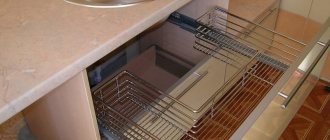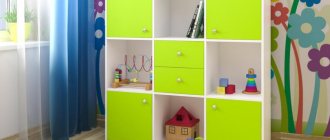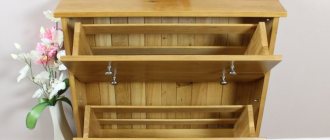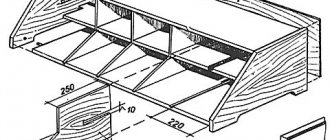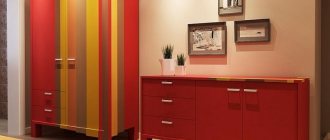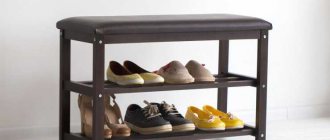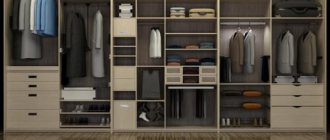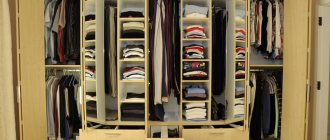Basic storage rules
The storage conditions of shoes significantly affect their properties, appearance, and durability. Its safety depends on many factors: exposure to sunlight, dust, humidity, room temperature, installation method, protection from moths and rodents. Having decided to organize a special maintenance system in your own home, you should adhere to certain rules:
- Initially, you should collect all the shoes, wash them, clean them of dirt, and dry them.
- The next step is to sort the items by season. It is necessary to separate spring, winter, summer, autumn models.
- Each pair must be carefully inspected. If defects are found, they will need to be corrected. If necessary, repair, glue the sole, replace the heel, insert the insole.
- Products that cannot be repaired should be disposed of. This step will save space and not clutter it with useless junk.
- To avoid deformation, delamination, and cracks, you need to straighten things out, put pads, paper, and plastic bottles inside.
- It is recommended to treat surfaces with softening cream and special substances appropriate for the material. This will prevent drying out and loss of shine.
- An important step is choosing a location. It should be dark, dry, and have good ventilation. Sunlight can lead to fading, high humidity can lead to the appearance of mold and mildew. It is also worth taking care of the distance from heating devices to avoid things from drying out.
- Perform zoning of space. Make room for men's, women's, and children's models. Provide for seasonal division.
- The ideal option would be to use a separate box for each pair.
Options for ready-made shelving
- One-piece. These designs include cabinets with sections for outerwear, things, shoes and shelves for accessories. These also include fabric systems, which consist of a metal frame and a fabric cover. Such systems can also be equipped with shelves for storing various clothes and accessories.
- Modular are the most popular and convenient systems. The rack consists of vertical racks and various drawers and shelves are mounted on them. The size of the modular shelving depends on the size of the dressing room. This option is also more popular because it can easily be made larger or smaller, and is also easy to install and maintain.
- Cabinet structures are modules for arranging a dressing room, consisting of several sections. Sections can be placed close to each other or separately.
- Frame structures. They are a device made of metal racks. Their advantage is ease of assembly, good ventilation of things and the ability to rearrange components. For this design, you can select absolutely any shelves, not only made of metal, but also made of wood.
Any shelving option must have the following departments:
- For storing shoes.
- Accessories.
- Section with a rod for storing shirts and trousers.
- For things.
Open shelves in the dressing room are rarely used, but if you place them near the ceiling, you will have free space that can be taken up with additional storage devices. In addition, rarely used or seasonal items can be stored on such shelves.
Roll-out shelves provide convenient storage space. You can store both things and accessories in them, and you won’t have to look for the necessary thing for a long time, since it will be immediately visible.
Multi-level racks can be of different sizes and can be equipped according to the following principle: insert drawers, baskets, shelves and other fillers into the lower sections, and equip the upper compartment for rarely used accessories. In a large dressing room, you can install two types of racks: with shelves and rods on which clothes are hung, and the upper section can be equipped with a pantograph.
The shape of the racks can be different: from U-shaped to parallel.
Dressing room and pantry: the best way to organize storage
In a large house, you can allocate a separate room for storing things. A walk-in closet is the perfect place to store all your shoes. Here you can provide special structures for placing items in sections. Properly organize a system for arranging everyday and seasonal shoes, and allocate a separate place for women's and men's models.
Owners of small apartments are less fortunate in this regard. But even in this case, do not despair. You can organize a dressing room in place of the pantry. For this, a room of 1 x 1.5 m is enough. It is necessary to take into account that the pantry is a closed space, so you will have to equip a forced ventilation system and choose the right lighting. After which you can place cabinets, bedside tables, racks, and shoe racks.
If for some reason it is not possible to convert the pantry, then you will have to look for alternative options. For example, in the summer, you can use a glazed balcony or loggia for these purposes. It is also worth thinking about the rational use of walls in the hallway or bedroom, equipping a special niche, and considering options for using pieces of furniture and the free space under them.
Sizes and shapes
The dimensions of the cabinet correspond to the number of future users and the parameters of the entrance room. If a spacious hallway can accommodate large voluminous furniture for shoes of any shape, then narrow compact models are suitable for small areas. Despite their modest size, they can be quite roomy. Such cabinets are located along the wall (rectangular options) or in a niche (corner models). If you need to store a lot of shoes in a cramped room, you can choose narrow but high furniture, right up to the ceiling. In addition to those mentioned, there are also square or rounded products that will decorate any hallway.
The standard depth of a shoe chest for average apartments is approximately 45 cm.
In small rooms, cabinets with dimensions of 60 × 30 × 100 cm (slim model) are installed. For a large hallway, furniture with the following dimensions is suitable: 100 × 40 × 140 cm.
Advantages of built-in wardrobes in the hallway, photos, their contents
Storing shoes in various boxes - their advantages and disadvantages
You can organize your shoe storage system in different ways. Things are placed in cabinets, on shelves, racks, and racks. Ordinary cardboard boxes and plastic containers are also used for these purposes. This is one of the most common and inexpensive methods that allows you to keep leg clothing in good condition. To place shoes, you can use original boxes, buy a product made of cardboard or plastic, or make a structure with your own hands.
Storage in shoe boxes
When buying shoes, few people think about the further method of storing them, so very often they throw away the original box. However, this is the best container that allows you to keep things in proper condition. Its parameters fully correspond to the specific model. Among the main advantages of using the item are:
- strength and durability of the material;
- easy maintenance, just wipe off the dust periodically;
- providing protection from the penetration of sunlight;
- preventing the formation of fungus and mold;
- maintaining the required level of humidity;
- you don’t have to pay more for the item;
- After deformation and expiration of its service life, the cardboard can be used to create various crafts, thrown away or taken to a waste paper collection point.
The disadvantages include:
- does not allow you to see which model is inside;
- each box has its own individual size, which makes it difficult to distribute them evenly;
- worn and frayed material itself becomes a source of dust, so allergy sufferers should consider other options.
Special cardboard boxes that have a uniform size standard will help solve the problem with straight rows.
Box design and labeling
When organizing storage in factory boxes, many people do not like the fact that if they have a large number of shoes, it is very difficult to find the right model. You have to open all the boxes and look at their contents. This is especially inconvenient when objects are stacked in rows on top of each other. After finishing the search, you need to reinstall everything in its place.
Thin and round
In many cases, standard options are completely unsuitable for specific needs. Models have been developed for such cases
- "slim" type - this is the name of a tall and narrow shoe rack in the hallway, produced for one-room and cramped apartments;
- in the form of a carousel counter with partitions, they are most suitable for families of five or more people.
Storing shoes in cabinets and drawers
A convenient way to store shoes in a small room involves hiding them from view. An ordinary closet can help with this. There are many devices that allow you to compactly arrange shoes and boots on racks where there is plenty of space. You can purchase special organizers or make shelves yourself. The latter option requires minimal costs, since any available materials can be used for its implementation. When choosing a storage method and materials for stands, it is necessary to take into account the temperature and humidity in a particular room.
In textile bags on open shelves
Storing shoes in a closet is a great option for large families with children. All pairs can be placed on deep shelves. There is enough space even for last year’s models or units from last season. Children's shoes will fit comfortably in small closed drawers; for larger models, you will need to provide special organizers and containers.
It is better to store shoes on open shelves in special packaging that will protect them from external influences and damage. Textile organizers are very popular. The device looks like an extended chest of drawers with many similar compartments. It can be placed on any wardrobe shelf, vertically or horizontally.
Winter shoes and high autumn boots can be stored in special fabric bags. At the bottom of the wardrobe section of the wardrobe, a simple clothesline is pulled. Pairs in covers are fixed to it using clothespins. This method will help avoid creases in the material and will allow you to carefully place nubuck ankle boots and suede boots.
What fabric to use and how to sew shoe bags yourself
To make simple shoe bags, you only need minimal sewing skills. It is not necessary to use a machine; beautiful stitching can be done by hand with a needle. First of all, you need to choose a suitable fabric. It should be dense but breathable material. Spunbond fabric is suitable for anthers. Shoe storage bags are made very simply:
- We determine the parameters of the boots. Add a few centimeters to the numbers for seams and volume allowance;
- We double the dimensions and measure out a piece of fabric;
- Fold the fabric in half, wrong side up, and baste, leaving one side open;
- We make a place for the lace - we bend both sides with a double fold and sweep it away;
- We sew according to the stitching areas;
- We thread the rope and turn it over the face.
Manufacturing materials
The shoe cabinet is made from durable materials that are resistant to dirt and moisture. Combination models that combine plastic, wood, metal, and textile elements are not uncommon. The cost and care features depend on the type and quality of the material.
- MDF, chipboard, fiberboard are raw materials for budget products. They are affordable for people with average incomes, have a variety of designs, and imitate real wood well. Suitable for styling a hallway like a classic.
- Natural wood is considered a very expensive option. Such furniture looks luxurious, is of unsurpassed quality and emphasizes the good taste of the owner. But she needs decent care.
- Solid metal structures fit well into the trends of minimalism, hi-tech, and loft. Sometimes only individual furniture elements are made of metal. Shelves made of this material are easy to clean. Often, forged cabinets are available in open type - overshoes.
- A rattan shoe rack is a beautiful, elegant wicker product, very popular, despite the high cost of the material. The cabinet is made from natural raw materials or its high-quality artificial substitute. The furniture will emphasize the individuality and originality of the interior; it is quite strong and durable, but requires proper care.
- Plastic cabinets belong to the category of cheap furniture. Modern models are distinguished by their beautiful design, richness of colors and shapes. With careful handling, high-quality material will last a long time. Caring for it is not difficult.
- Products made from high-strength glass look very stylish and elegant, giving the interior an airiness and weightlessness. Due to the fact that the material is quite massive, it is resistant to damage and shock. Doors or shelves are made of durable glass. Such a cabinet requires careful care, since all dirt will be immediately visible. Most often they use frosted opaque glass of any color. An excellent option is a mirror facade, which is placed on the cabinet door.
- Textile. An inexpensive and not very durable material, it gets dirty quickly and is inconvenient to clean. But the fabric allows air to pass through well, it can be washed, and the product itself is portable, as it weighs little. The design is often complemented by a zipper, which allows you to store shoes closed, protecting them from dust. This shoe rack is more suitable for temporary use in a rented apartment.
Advantages of modular furniture for the hallway, its main dimensions
When choosing a material, it is important to focus on the design style of the hallway: the product should not stand out from the overall interior and look like an awkward “spot” against the background of the rest of the furniture.
Tree
Chipboard
MDF
Plastic
Rattan
Textile
DIY devices
There are many original ideas for arranging shoe storage. Convenient organizers, massive shoe racks, hanging racks and shelves are made to a certain standard. They are not always suitable in style and size for small dressing rooms or hallways. Homemade devices will last no less, but will add a certain zest to the interior of the room.
Rails and strips for storing shoes
You can organize compact shoe storage from long strips or sections of cornice. The convenient railing system is very popular. It is often used in spacious wardrobes to save space. Anyone can make an original stand with their own hands from scrap materials, based on a detailed description of the work progress.
You can install shoe rails at the bottom of the closet or niche. First, we measure the distance from one wall to the other and cut off two pieces of cornice with a small margin. We mark the location of the holes and drill the recesses. We place homemade roof rails one above the other. In this way, you can make holders for light shoes on the inside of the cabinet door.
PVC pipe rack for shoes
Light plastic can be used to make a beautiful shoe shelf or a large industrial-style rack. For the work you will need the pipes themselves, fittings, corners, and flat boards. First of all, we make a detailed drawing. It is necessary to indicate the specific installation location, the number of crossbars, and design parameters (height, width, depth).
Having prepared and cut the parts to size, you can proceed to assembling the rack. All elements must be assembled according to the previously created diagram. We put plugs on the legs and lean part of the structure against the wall. We make four holes in the wooden boards along the edges with a diameter slightly larger than the pipe. We thread them through, placing them at the required distance from each other. To increase the strength of the rack, the plastic joints can be additionally secured with self-tapping screws. If necessary, the pipes can be cleaned with sandpaper and painted with spray paint.
Posting rules
Elongated and square, spacious and small-sized, with niches and storage rooms - the options for hallways are varied. Owners of private houses with spacious halls are the least limited in their options, because the shoe cabinet you like can be placed anywhere. Those with narrow spaces have to work hard when choosing the optimal location for the closet. One rule is universal - the storage space should be located as close as possible to the front door. This is convenient and practical, because dirty shoes will stain the floor surface minimally.
It is worth filling the corners of the hallway as much as possible with useful furniture, freeing up space for passage. After placing the cabinet in the hallway there should be at least 80 cm, the cabinet should not interfere with movement.
Narrow, narrow corridors can be equipped with a sliding wardrobe, placing it along a long wall. Also, a sliding wardrobe outperforms a wardrobe with doors, since not every narrow hallway has room for swinging doors. When choosing a sliding wardrobe, it is more convenient to use several narrow doors than one meter long.
A square hallway can be equipped with a corner shoe cabinet. If the room has a niche or storage room, then it can be used as a place to store shoes and things. It is enough to think over a convenient configuration of the shelves, and the door can be ordered in showrooms offering sliding wardrobes. Also available on the market are ready-made built-in wardrobes designed specifically for placement in niches.
A shoebox, cabinet or slim cabinet can be placed to the right or left of the front door. It is important to consider in which direction the door opens, so that this placement option does not cause discomfort. Also, open or closed shoe cabinets are often placed at the entrance. The doors can slide or open, the shelves are stationary or retractable. There are special vinyl shelves for wet shoes. They are equipped with special trays where water and dirt flow through the holes.
How to properly care for and store shoes
Proper storage and care will extend the life of your shoes. Maintaining optimal temperature and humidity at its location will preserve its appearance without losing the quality characteristics of the material. Many of its species are very capricious. Therefore, it is necessary to protect your favorite shoes and boots as much as possible from contact with moisture, dust, and dirt. Care measures should include cleaning, washing, drying. For certain types of material, polishing and impregnation are used.
Leather
Before hiding leather shoes in a box, you need to carry out standard procedures: wash the soles, remove dirt and dust from the upper part and dry. If these are winter boots, the insoles must be removed and washed separately. Fasteners and locks must be unfastened and left open. Dried shoes should be soaked in protective cream several times and left on an open shelf until completely absorbed.
To keep boots or shoes in shape, crumpled paper or special foam products are placed in socks. If these are fur boots, they must be treated with a remedy against moths and other pests. It is better to store leather and leatherette in its natural position, without bending or twisting the tops. Low shoes are placed on the soles, and high ones are laid horizontally or hung in a case.
Leather shoes can only be dried outdoors. Do not place boots near open fires or heating devices.
Suede and nubuck
For regular care and preparation for storage, only products specifically designed for the material should be used for suede and nubuck. To clean fleecy shoes, use rubber brushes or a simple office grater. Suede products are not afraid of moisture, so they can be easily washed with warm water. Nubuck can only be cleaned with a dry brush.
Suede and nubuck shoes should be stored at average room temperature. Cured leather does not tolerate heat or cold. You cannot leave products on the balcony or in the garage in winter. Breathable materials must be used for packaging. Cardboard or a textile bag will do. Each boot must be wrapped separately.
Rubber Shoes
In order for rubber boots to perform their functions for as long as possible and maintain their integrity, it is necessary to provide them with high-quality care. It is necessary to wipe off moisture from both the outer and inner surfaces. You can remove dirt or scratches from white items using an eraser or a piece of rubber.
Before storing boots for long-term storage, the entire surface should be treated with glycerin or special oil for rubber products. If they have been worn for a long time, the inside must be disinfected. To treat and eliminate unpleasant odors, use a weak solution of potassium permanganate or hydrogen peroxide.
The storage space for rubber shoes should be spacious and not require squeezing or bending. The optimal temperature is 5-15 °C. Models with high tops are stored in an upright position.
Patent leather shoes
Only special care products are suitable for such products. Impregnations for varnish are water-based, which provides soft, gentle moisture. You can even disguise scratches and abrasions with a simple nail polish of a suitable color. To soften the material and prevent cracking, it is recommended to use Vaseline after each contact with water.
Since patent leather shoes are not intended for daily wear, it is very important to ensure proper storage. To maintain the shape of a varnished pair, special holders are used - blocks made of wood, plastic, or foam. They are placed inside and twisted, stretching the boots in width and length. Patent leather shoes must be stored in separate bags. Shiny surfaces should not touch, otherwise they may become dull or scratched.
Open and closed structures
Depending on the storage method, shoe racks are
- open, in which the boots dry at room temperature and at the same time are ventilated from the smell of sweat;
- closed, looking like a medium-sized chest of drawers. In some cases, they include a soft seat. Because this storage method prevents natural drying, the furniture must have holes for constant ventilation.
Lighting in the dressing room
According to the rules, the dressing room must be illuminated by at least one window. This saves energy and allows you to find things without the light on.
Lighting planning begins with dividing the wardrobe into zones.
The first zone includes a section 150 cm high with outerwear, the second contains short clothes and is 100 cm high, the third zone is for shoes. Where there will be a fitting room, a full-length mirror is needed.
Places with mirrors require separate lamps around them. After all, the fitting place is the most important, where a person looks at himself and evaluates his appearance.
The main task is to choose lighting that will be bright, but not cause eye strain.
Using different light sources in the dressing room
If the room has suspended ceilings, it is recommended to use built-in devices with a wide dispersion angle. For ordinary ceilings, chandeliers and ordinary lamps are used. The most convenient are rotating lamps that you can direct yourself.
Rules for choosing lighting:
- You should choose economical lamps.
- The lighting is as natural as possible.
- There is no need to choose lamps that are too bright.
- Lighting should be planned before installing cabinets and shelving.
- If the wardrobe is small, you should not illuminate the mirror.
It is logical to arrange all seasonal shoes in the dressing room on convenient racks or open shelves
Shoe pincushion
Children's shoes are especially suitable for making pincushions, because they are optimal in size. If the child has grown up, or one of the shoes has been lost, it is worth showing your imagination and making this convenient sewing accessory.
To fill a future pincushion, a piece of padding polyester or the contents of an unnecessary soft toy will be suitable. It is placed inside the shoe, covered with beautiful fabric or lace on top, and decorated with any decor (optional). Then they stick needles and pins into the needle case and place this beautiful product in a visible place.
Decor for a summer house made from throwaway shoes
Disused boots, sneakers, boots and other footwear can become the basis for creating country decorations and landscaping items. The easiest way is to use them as a replacement for flower beds: pour soil inside, install them in a suitable place and plant them with flowering plants.
Plants with a small root system are ideal for this purpose: pansies, daisies, hydrangeas. Flowerbeds-boots look very nice, standing next to benches or along garden paths.
For an outdoor shoe pot, it is not necessary to use a stand - excess water will simply go into the ground. Otherwise, its technology is similar to that used for indoor pots.
If you want to make a hanging planter out of a shoe, you can put a small plastic pot inside and secure it with reliable glue. This product looks stylish and decorates the garden area.
Garden paths
If you have several pairs of old shoes that are very worn, you can use only the soles. They are used to make a stylish and very inexpensive path in the garden or a small area near the house.
Important! The original path will not only last for many years, but will also become a decorative element of the local area.
Shoe jewelry stand
From an ordinary old shoe you can build an original rack for jewelry and costume jewelry for a dressing table. This stylish organizer will allow you to place an impressive number of ladies' items and prevent them from getting mixed up.
To make a practical storage system with your own hands, you need:
- Rinse well and clean shoes.
- Paint the product with acrylic paint along with the heel or decorate it in another way.
- Place thick synthetic padding inside the shoes.
- Make cuts for rings and earrings.
- Place jewelry for storage.

